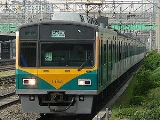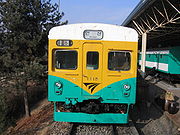
Korail Class 1000
Encyclopedia
Korail Class 1000 is commuter electric multiple unit
in South Korea
for using in Seoul Subway Line 1
. Class 1000 trains entered service between 1974 and 1996.
, while car body was based on JNR 103 series
. The exterior sections of the 1st and 3rd batches were subsequently used on Seoul Metro 1000 series' 1st and 2nd batches.
10XX - Tc (trailer car with control room)
12XX - M (air compressor, battery, main resistor and controller)
13XX - M' (transformer, SIV, pantograph)
18XX - T (trailer car)
14XX - M
15XX - M'
19XX - T
16XX - M
17XX - M'
11XX - Tc
Usually they are 6M 4T with TC-M-M'-T-M-M'-T-M-M'-TC, but this can vary when trains enter depots.
 Trainsets 101~141 are 1st batch trains and were introduced from 1976 to 1985. Their general outlook was similar as Japanese EMUs, since trainsets 101~114 were assembled by various Japanese companies, though trainsets 115~141 were built by Korean companies including Daewoo Heavy Industries under license. As a result, trainset 115 is nicknamed "The First Korean EMU". All of the 1st batch trains were based at Guro train depot and bore the old Korean National Railroad (KNR) livery.
Trainsets 101~141 are 1st batch trains and were introduced from 1976 to 1985. Their general outlook was similar as Japanese EMUs, since trainsets 101~114 were assembled by various Japanese companies, though trainsets 115~141 were built by Korean companies including Daewoo Heavy Industries under license. As a result, trainset 115 is nicknamed "The First Korean EMU". All of the 1st batch trains were based at Guro train depot and bore the old Korean National Railroad (KNR) livery.
The 1st batch trains were retired in 2006.
Out of this batch, trainsets 153, 157, 163 and 165 were retired in 2006 as converted trainsets 182 and 187~194, being coupled with some 1st batch trains. The remaining cars are based from the following depots:
EMUs. 3rd batch trains were introduced for increasing needs in triple-track section and for lengthening Gyeongwon Line
's EMU to 10 car trains (though they have been shortened back to 8 cars after the current Jungang Line was extended to Paldang and Guksu, and later on shortened to 6 cars). The front view is based on Class 341000 and Class 351000 trains. All of the 3rd batch trains had the old Korean National Railroad (KNR) livery but they have received new livery following refurbishment.
The 3rd batch cars are based from the following depots:
Some 2nd batch trains were also retired, but were either connected to Class 311000 trains or refurbished as cabin cars, were renumbered into trainsets 182, 187~194 and were linked with 1st batch trailer cars. When more older cars were retired, there weren't enough motor cars to control, so these trainsets were retired in 2006 and are currently stored at the Byeongjeom car depot.
As of 2011, units 1001, 1115, 1315 are preserved at Korean Railroad Museum in Uiwang
, with units 1115 and 1315 are part of Korean 1st EMU. When they were just preserved, they were renumbered to 1001 and 1201, causing some controversy. Refurbished 1st batch trailer car 1091 is used as theme park at Buljeong station on the Mungyeong line.
The remaining 2nd batch and 3rd batch trains (and 1st batch trailer cars) are to be replaced with Class 312000 trains in the near future.
Electric multiple unit
An electric multiple unit or EMU is a multiple unit train consisting of self-propelled carriages, using electricity as the motive power. An EMU requires no separate locomotive, as electric traction motors are incorporated within one or a number of the carriages...
in South Korea
South Korea
The Republic of Korea , , is a sovereign state in East Asia, located on the southern portion of the Korean Peninsula. It is neighbored by the People's Republic of China to the west, Japan to the east, North Korea to the north, and the East China Sea and Republic of China to the south...
for using in Seoul Subway Line 1
Seoul Subway Line 1
Seoul Subway Line 1 of the Seoul Metropolitan Subway, formerly known as the Korea National Railroad of Seoul, is an operation channel which links central Seoul, South Korea to Soyosan Station in the northeast, Incheon in the southwest, and Asan via Suwon in the south. This line covers a large part...
. Class 1000 trains entered service between 1974 and 1996.
Technical details
In 1974 South Korea had no experience of manufacturing and operating EMUs, so the Class 1000 trains were based on Japanese trains. Electric parts were based on JNR 415 series415 series
The is a suburban EMU introduced in 1971 by Japanese National Railways , and currently operated by JR East, JR Kyushu, and JR West in Japan.The 415 series is descended from the following types.* 401 series* 403 series* 421 series* 423 series-Variants:...
, while car body was based on JNR 103 series
103 series
The is a commuter electric multiple unit type introduced in 1964 by Japanese National Railways , and currently operated by West Japan Railway Company and Kyushu Railway Company . They were also operated by East Japan Railway Company and Central Japan Railway Company .-Prototype:Built in 1963...
. The exterior sections of the 1st and 3rd batches were subsequently used on Seoul Metro 1000 series' 1st and 2nd batches.
Formation
In 10 car formation, TC-M-M'-T-M-M'-T-M-M'-TC.10XX - Tc (trailer car with control room)
12XX - M (air compressor, battery, main resistor and controller)
13XX - M' (transformer, SIV, pantograph)
18XX - T (trailer car)
14XX - M
15XX - M'
19XX - T
16XX - M
17XX - M'
11XX - Tc
Usually they are 6M 4T with TC-M-M'-T-M-M'-T-M-M'-TC, but this can vary when trains enter depots.
1st batch

The 1st batch trains were retired in 2006.
2nd batch
Trainsets 142~173 are 2nd batch trains and were introduced from 1986 to 1992. The front view and window type has changed, and a train event recorder was also introduced. Since this batch is equipped with air-conditioning, SIV was introduced for air conditioner's power. All of the 2nd batch trains had the old Korean National Railroad (KNR) livery but they have received new livery following refurbishment.Out of this batch, trainsets 153, 157, 163 and 165 were retired in 2006 as converted trainsets 182 and 187~194, being coupled with some 1st batch trains. The remaining cars are based from the following depots:
- Guro: 142~152, 154~156, 158~162, 164, 166.
- Imun: 167~173
3rd batch
Trainsets 174~186 are 3rd batch trains and were introduced before the Class 311000Korail Class 5000
Korail Class 311000 is commuter electric multiple unit in South Korea for using in Seoul Subway Line 1. Class 311000 trains entered service between 1996 and 2006, and were introduced in 1996 for use in 6-track sections of the Gyeongbu Line, the newly created 4-track Gyeongin Line, and for replacing...
EMUs. 3rd batch trains were introduced for increasing needs in triple-track section and for lengthening Gyeongwon Line
Gyeongwon Line
The Gyeongwon Line is a railway line serving northeastern Gyeonggi Province in South Korea. The line is operated by Korail. The name of the line came from Gyeongseong and Wonsan, the original terminus of the line in what is now North Korea.-History:The Gyeongwon line was opened along its full...
's EMU to 10 car trains (though they have been shortened back to 8 cars after the current Jungang Line was extended to Paldang and Guksu, and later on shortened to 6 cars). The front view is based on Class 341000 and Class 351000 trains. All of the 3rd batch trains had the old Korean National Railroad (KNR) livery but they have received new livery following refurbishment.
The 3rd batch cars are based from the following depots:
- Imun: 174
- Guro: 175~181, 183~186 (trainset 182 was reserved for refurbished 1st/2nd batch trainset 182)
Refurbishments
- For air conditioning, secondary power device was changed in 1986 from motor generator to inverter. Then in 2004 they were replaced by new IGBT-inverter. Air conditioner was changed from piston type to screw motor type.
- From 1988 1st batch cars were refurbished for air conditioning.
- From 2000 TIS was installed in 2nd, 3rd batch cars. For rapid train, stop notifier was also installed.
- From 2003 the Daegu subway fireDaegu subway fireThe Daegu subway fire was a mass murder suicide attack on February 18, 2003 which killed at least 198 Koreans and injured at least 147. An arsonist set fire to a train stopped at the Jungangno Station of the Daegu Metropolitan Subway in Daegu, South Korea...
resulted in the need to introduce flame-resistant interiors for passengers safety, so the interior of all Korail trains was changed into flame-resistant type. Cars at and above the 5-year lifespan were refurbished. Front and side destination signs, as well as some train number indicators were upgraded from film to LED. - From 2006 to 2007 some of 1st batch trailer cars were repainted into new Korail livery, and interiors were replaced into inflammable type. They are connected to some of 2nd and 3rd batch cars.
- From 2007 some of 2nd batch cars' door was changed.
Retirement and preservation
Most 1st batch trains were retired scrapped between 1999 and July 2004 (others remained in service until 2006) as their lifetime (25 years) was finished, except for units 1001, 1115, 1315 and 1091 and several trailer cars which are currently connected to some newer batch trainsets (and retain their numbers).Some 2nd batch trains were also retired, but were either connected to Class 311000 trains or refurbished as cabin cars, were renumbered into trainsets 182, 187~194 and were linked with 1st batch trailer cars. When more older cars were retired, there weren't enough motor cars to control, so these trainsets were retired in 2006 and are currently stored at the Byeongjeom car depot.
As of 2011, units 1001, 1115, 1315 are preserved at Korean Railroad Museum in Uiwang
Uiwang
Uiwang is a city in Gyeonggi Province, South Korea. It is one of many satellite cities that ring Seoul, making up the Seoul National Capital Area. Its largest immediate urban neighbor is Anyang...
, with units 1115 and 1315 are part of Korean 1st EMU. When they were just preserved, they were renumbered to 1001 and 1201, causing some controversy. Refurbished 1st batch trailer car 1091 is used as theme park at Buljeong station on the Mungyeong line.
The remaining 2nd batch and 3rd batch trains (and 1st batch trailer cars) are to be replaced with Class 312000 trains in the near future.
See also
- KorailKorailKorea Railroad Corporation , promoted as Korail , is the national railroad operator in South Korea.Korail operates passenger and freight trains throughout South Korea...
- Seoul Subway Line 1Seoul Subway Line 1Seoul Subway Line 1 of the Seoul Metropolitan Subway, formerly known as the Korea National Railroad of Seoul, is an operation channel which links central Seoul, South Korea to Soyosan Station in the northeast, Incheon in the southwest, and Asan via Suwon in the south. This line covers a large part...

